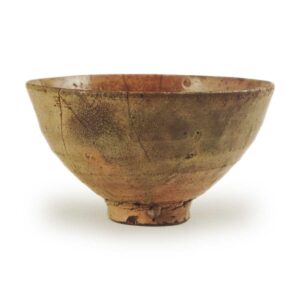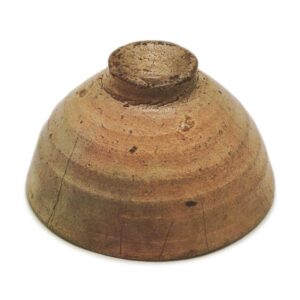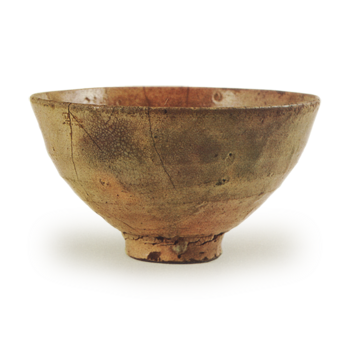

Height: 8.5 – 9.0 cm
Diameter: 15.0 – 15.1 cm
Outer diameter of foot ring: 5.0 – 5.3 cm
Height of foot ring: 1.5 cm
This name comes from the fact that it was owned by Tsuda Sōkyū of Sakai, who served Hideyoshi alongside Sen no Rikyū and Imai Sōkyū and was known as one of the three great masters of the tea ceremony.
The Nezu Museum also has a famous tei-do with the same “Sou-o-ki” signature, and the inscription on the inner box reads “Well, Sou-o-ki possession, teacup”, and at first glance the two look very similar, but the Nezu “Sou-o-ki” is larger than the teacup shown here, with a height of 9.73cm and a diameter of 17.16cm. The glaze, the way it was made, and especially the foot ring, are different.
This So-yu is not recorded in the Taisho Meiki Kan, but in terms of appearance it is similar to the Yuraku, Tsushima, Echigo, and Kinjii styles, and is one of the most outstanding tea bowls of the famous Tei-do collection.
The clay is rough and sandy, and a thick, clear white glaze is applied generously to it. There are rough cracks all over the surface, and the foot and base, which have a particularly thick glaze, have even rougher cracks. The shape is typical, with a wide mouth and a high, solid foot, and the rim is thick, giving the tea bowl a dignified, stately appearance. Three thick, strong lines of the potter’s eye run around the lower half of the body, and the foot has been scraped down to a single flat surface, creating a bamboo-joint foot. A kabuto-kin (helmet-shaped cloth) stands on the bottom, and there is a single scratch on the foot. The tatami mat is exposed, but there are five faint traces of the eye. The inside is deep, with a bulge in the middle, and there is a single crack on the side. As with Kizaemon, Kaga, and Hosokawa, there are no eyes on the inside, and the gentle, slow-turning lathe marks circle around the inside.
The firing is slightly oxidized, and the overall color is loquat-colored, but there are also parts that have turned a light grayish-brown. The kiln temperature was high for this well, and it is one of the most burnt tea bowls, with a strong luster on the glazed surface and the kaeragi (flowering quince skin) almost melting.
The exposed clay on the side of the foot ring is thought to have been caused by the action of the shellfish poison, as in the Kizaemon well, but there is not as much exposed clay on the foot ring as there is in the Kizaemon well.
There are three loose threads on the rim, and six very small loose threads, as well as gold lacquer and other lacquer work. There are several large and small gutters, and for a well that is prone to damage, it is almost perfectly intact.
It was originally in the possession of the Hachisuka family, and from the Meiji to Taisho periods it was in the possession of the Umakoshi family.
The inner box is inscribed in gold with the name “Soukyu”, and the outer box is inscribed in silver with the words “well” on the upper right and “tea bowl” on the lower left.



